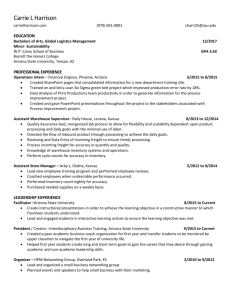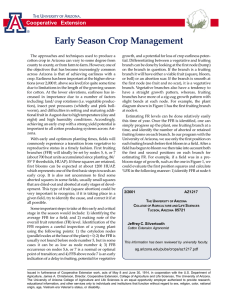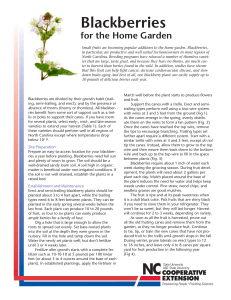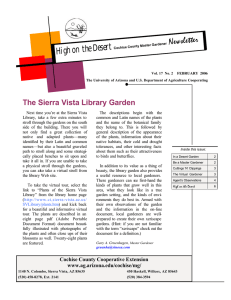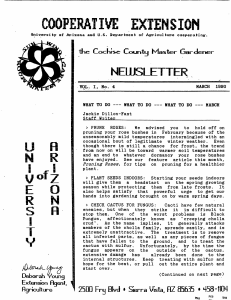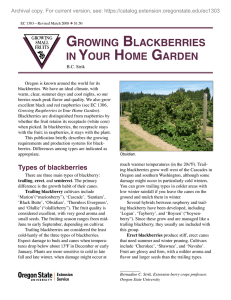Growing Blackberries in the Low Desert E TENSION Varieties
advertisement
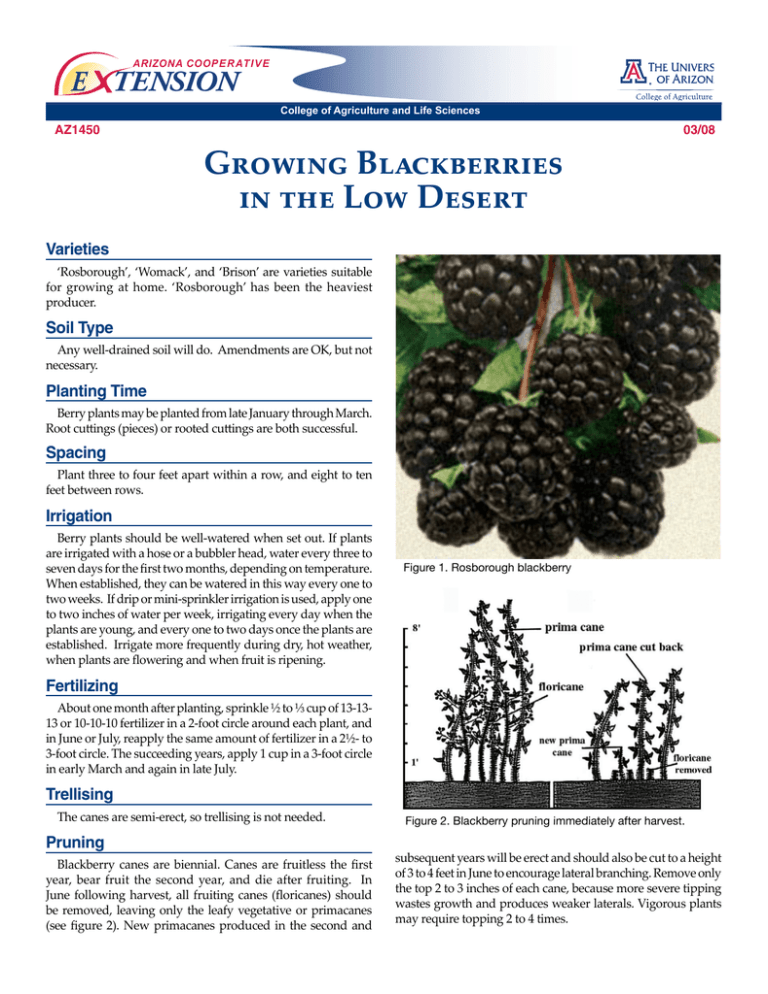
ARIZONA COOP E R AT I V E E TENSION College of Agriculture and Life Sciences AZ1450 03/08 Growing Blackberries in the Low Desert Varieties ‘Rosborough’, ‘Womack’, and ‘Brison’ are varieties suitable for growing at home. ‘Rosborough’ has been the heaviest producer. Soil Type Any well-drained soil will do. Amendments are OK, but not necessary. Planting Time Berry plants may be planted from late January through March. Root cuttings (pieces) or rooted cuttings are both successful. Spacing Plant three to four feet apart within a row, and eight to ten feet between rows. Irrigation Berry plants should be well-watered when set out. If plants are irrigated with a hose or a bubbler head, water every three to seven days for the first two months, depending on temperature. When established, they can be watered in this way every one to two weeks. If drip or mini-sprinkler irrigation is used, apply one to two inches of water per week, irrigating every day when the plants are young, and every one to two days once the plants are established. Irrigate more frequently during dry, hot weather, when plants are flowering and when fruit is ripening. Figure 1. Rosborough blackberry Fertilizing About one month after planting, sprinkle ½ to ⅓ cup of 13-1313 or 10-10-10 fertilizer in a 2-foot circle around each plant, and in June or July, reapply the same amount of fertilizer in a 2½- to 3-foot circle. The succeeding years, apply 1 cup in a 3-foot circle in early March and again in late July. Trellising The canes are semi-erect, so trellising is not needed. Pruning Blackberry canes are biennial. Canes are fruitless the first year, bear fruit the second year, and die after fruiting. In June following harvest, all fruiting canes (floricanes) should be removed, leaving only the leafy vegetative or primacanes (see figure 2). New primacanes produced in the second and Figure 2. Blackberry pruning immediately after harvest. subsequent years will be erect and should also be cut to a height of 3 to 4 feet in June to encourage lateral branching. Remove only the top 2 to 3 inches of each cane, because more severe tipping wastes growth and produces weaker laterals. Vigorous plants may require topping 2 to 4 times. Propagation Plants may send up shoots from the roots. These may be dug and replanted. Diseases, Insects and Birds Blackberries have few disease or insect problems, except for occasional mites. Birds may be a problem in some areas, so netting should be considered. Fruit may also become sunburned late in the harvest season. Shading may help reduce sunburn. Yield Plants will produce 3 to 10 pounds of fruit per plant beginning at age three. Fruit should ripen beginning in early May, and continue for 3 to 4 weeks. Fruit is sweetest when “dull black”. ARIZONA COOP E R AT I V E E TENSION THE UNIVERSITY OF ARIZONA COLLEGE OF AGRICULTURE AND LIFE SCIENCES The University of Arizona College of Agriculture and Life Sciences Tucson, Arizona 85721 Dr. Glenn C. Wright Associate Research Scientist, Plant Science Yuma Mesa Agriculutre Center Contact: Dr. Glenn C. Wright gwright@ag.arizona.edu This information has been reviewed by university faculty. cals.arizona.edu/pubs/garden/az1450.pdf Issued in furtherance of Cooperative Extension work, acts of May 8 and June 30, 1914, in cooperation with the U.S. Department of Agriculture, James A. Christenson, Director, Cooperative Extension, College of Agriculture & Life Sciences, The University of Arizona. The University of Arizona is an equal opportunity, affirmative action institution. The University does not discriminate on the basis of race, color, religion, sex, national origin, age, disability, veteran status, or sexual orientation in its programs and activities.





